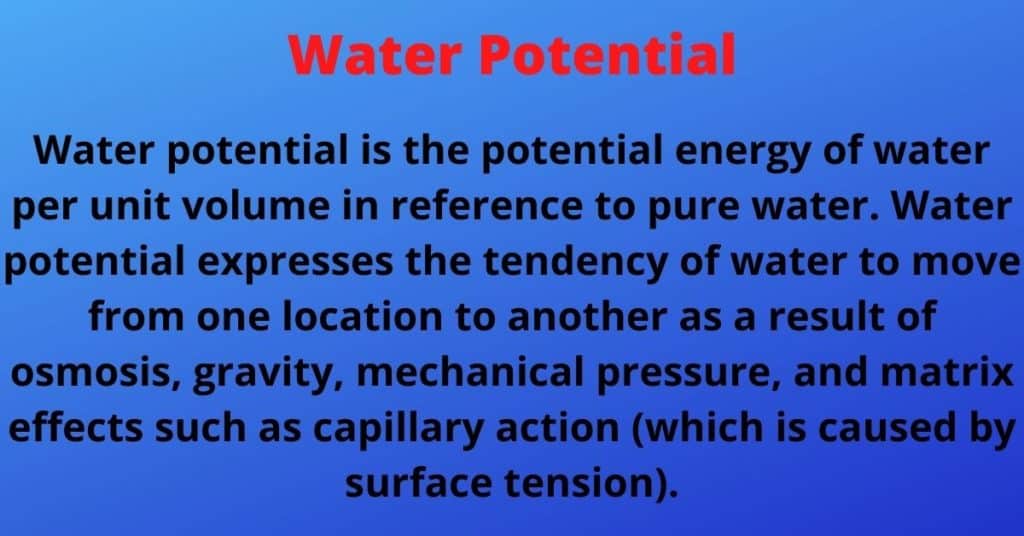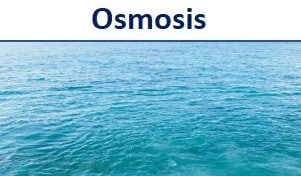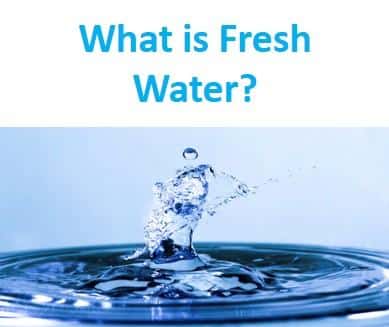Water potential is the potential energy of water per unit volume in reference to pure water. It expresses the tendency of water to move from one location to another as a result of osmosis, gravity, mechanical pressure, and matrix effects such as capillary action (which is caused by surface tension).
Water potential has been found to be useful in understanding and computing water movement within plants, animals, and soil. It is denoted by the Greek letter ψ (psi) and is expressed in units of pressure (pressure is a form of energy) called megapascals (MPa).

In simpler terms, Water Potential is a measurement of the concentration gradient of free water molecules. The greater the number of free water molecules, the greater the water potential. Water diffuses through the concentration gradient by osmosis from a region of high potential to a region of low potential. The low water potential means that there are few forces driving the water to move from one location to another, and the water will tend to remain where it is. Pure water in an open container has no water potential because there is no solute and no pressure.
Plants use water potential to transport water to the leaves so that photosynthesis can take place.
Water potential and gradients also have an impact on water flow through plants, which is an important link in the hydrologic cycle. A good example is a water moving up a tree’s stems from the roots is a good example. The water potential of the roots is higher than that of the stems.
Accumulated salt reduces the osmotic potential of soil water and thus the rate of root water uptake. Thus, as the salt concentration in soil water increases due to root water uptake, the patterns of water uptake and salt accumulation change over time.
Water potential is affected by factors such as pressure, gravity, and matric potentials.
The greater the difference in water potential, the faster the osmosis; because fewer water molecules are in the low concentration region, more water molecules from the high concentration region can enter faster and easier. Pure water has the highest water potential because it is lacking solutes.
The main distinction between water potential and osmotic potential is that the former is a measure of the concentration of free water molecules, whereas the latter is a measure of a solution’s tendency to withdraw water from pure water via osmosis through a semi-permeable membrane.
Table of Contents
Real Life Examples of Water Potential
| Plant Water Uptake | Water potential plays a crucial role in the uptake of water by plant roots. The water potential of the soil determines the direction of water movement, with water moving from regions of high water potential (soil) to regions of low water potential (root). The water potential of the plant cell also determines the movement of water from the root to the leaves. |
| Water Loss in Transpiration | The water potential of the air surrounding a plant can affect the rate of transpiration, which is the process by which water is lost from the leaves. The drier the air, the lower its water potential, and the faster the rate of transpiration. |
| Osmosis in Animal Cells | Water potential also plays a role in osmosis in animal cells. For example, when a red blood cell is placed in a hypotonic solution (low solute concentration), water moves into the cell, increasing its volume and causing it to swell. Conversely, when the cell is placed in a hypertonic solution (high solute concentration), water moves out of the cell, causing it to shrink. |
| Saltwater Intrusion | Water potential can also have an impact on saltwater intrusion in coastal aquifers. When freshwater is pumped out of the aquifer, the water potential in the aquifer decreases. This can cause saltwater from the nearby ocean to flow into the aquifer, contaminating the freshwater. |
| Cooking | Water potential is also relevant in cooking. For example, when boiling vegetables, the water potential of the boiling water can affect the rate at which the vegetables cook. Vegetables placed in water with a higher water potential (i.e., less salty water) will cook faster than those placed in water with a lower water potential (i.e., saltier water). |
Gradient Definition
A gradient is a relationship between a change in one variable, such as concentration, pressure, or temperature, and a change in another variable, usually distance.
Some of the examples of the gradient are listed below:
- Concertation gradient: change in concentration over a distance
- Pressure gradient: change in pressure over a distance
- Temperature gradient: Change in temperature over a distance
Summary
- The potential energy of water per unit volume in comparison to pure water is referred to as water potential.
- The Greek letter ψ denotes water potential, which is commonly expressed in potential energy per unit volume.
- Conventionally, the water potential of pure water at room temperature is assumed to be zero.
Related Topics
Surface Tension of Water
How Many Water Bottles is a Gallon
How Much Does a Gallon of Water Weigh?
How Much is a Liter of Water?
Exams Related Questions
| Question Number | Exam Question | Answer |
|---|---|---|
| 1 | Define water potential and explain its units | Water potential is the potential energy of water in a system relative to pure water. Its units are typically in bars (or megapascals). |
| 2 | How does solute potential affect water potential? | Solute potential lowers water potential by reducing the amount of free water molecules available for movement. |
| 3 | Describe the process of osmosis and its relationship to water potential | Osmosis is the diffusion of water across a selectively permeable membrane. Water moves from regions of high water potential to regions of low water potential. |
| 4 | Explain how pressure potential affects water potential | Pressure potential can either increase or decrease water potential depending on the direction of water movement. When water moves from a high pressure region to a low pressure region, pressure potential decreases water potential. |
| 5 | How do you calculate water potential in a plant cell? | Water potential in a plant cell is calculated using the formula ψ = ψs + ψp, where ψs is solute potential and ψp is pressure potential. |
| 6 | How does water potential affect plant water uptake and transport? | Water potential drives the movement of water through plant tissues via osmosis. Water moves from regions of high water potential to regions of low water potential. |
| 7 | Describe the concept of water potential gradient and its importance in plant physiology | Water potential gradient refers to the difference in water potential between two adjacent regions. This gradient is important for plant physiology because it drives water movement from roots to leaves, and from soil to roots. |
| 8 | How does water potential influence the direction of water movement in plant tissues? | Water moves from regions of high water potential to regions of low water potential. Therefore, if a region of a plant has a higher water potential than its surroundings, water will move into that region. |
| 9 | How can changes in water potential affect plant growth and development? | Changes in water potential can affect plant growth and development by altering water uptake, turgor pressure, and nutrient transport. These factors can influence plant cell expansion, stomatal conductance, and photosynthesis. |
| 10 | Explain the role of aquaporins in water transport across cell membranes | Aquaporins are membrane proteins that facilitate the diffusion of water across cell membranes. They play an important role in regulating water uptake and transport in plant and animal cells. |
Frequently Asked Questions
1. What is the density of water?
Water has a density of about 1 gram per milliliter, but this varies depending on temperature and whether or not substances are dissolved in it. Ice floats on water because it is less dense than water. Furthermore, The density of water is the weight of water per unit volume, which varies according to the temperature of the water.
2. What is the density of water value in g/ml?
The density of water in g/ml is 0.9998395 at 4.0°C (39.2°F). This is equal to a rounded value of 1 gram per milliliter (g/ml) or 1 gram per cubic centimeter (g/cm3).
3. how many water bottles are half a gallon?
A gallon (gal) is 231 cubic inches in the United States, which is equal to 3.785 liters or 7.58 bottles of water. One gallon is equal to 4.55 liters and 9.1 bottles in the Imperial system of the United Kingdom. Similarly, one gallon equals 128 imperial fluid ounces, while a half-gallon equals 64 fluid ounces. Therefore, a half-gallon (USA) contains 3.79 bottles of water and a half-gallon (imperial system) contains 4.55 bottles of water. Check the full article here “how many water bottles is a gallon”.
4. What is the weight of water per gallon?
The weight of water per gallon (US) is 8.35 pounds or 3.785 kg at 17 °C.
The weight of water per gallon (imperial system) is 10.02 pounds or 4.545 kg at 17 °C.
5. How many cups in a gallon?
A US liquid gallon is equal to 16 cups, and a US dry gallon is equal to 18.61 cups. In the United States, one cup equals half a pint (236.6 ml). Check the full article “How many cups in a gallon?”.
6. how many cups is 128 ounces?
128 ounces equals 16 cups; in the United States, one cup equals half a pint (236.6 ml).
7. What temp does water freeze?
Water’s normal freezing and melting points are 0°C and 32°F.
What temperature does water freeze? is much more intricate than it appears. Clouds contain liquid water as cold as -40°F, and scientists have attained chilled water temperature to -42°F in the lab.
8. Does water cause weathering or erosion?
Water causes weathering. After a rock has been broken down, a process known as erosion carries the rock and mineral fragments away.
9. is water a pure substance?
Water is a pure substance, a hydrogen-oxygen compound. Although water is the most abundant substance on the planet, it is rarely found in its pure form in nature.
Please check the full article “Is water a pure substance?”.
10. the viscosity of water?
The viscosity of water at 20 degrees Celsius is 0.01 poise r 0.001 Pa.s (Pascal seconds).
11. Proportionality constant?
The proportionality constant is a mathematical and physical term that describes a linear connection between two numbers or variables. If one variable doubles in size, the other does as well; if one variable drop in size, the other does as well.
More Interesting Topics
The Density of Water lbs/U.S gal
Density of Water in g/ml-Accurate Value
Is Nh3 Polar?
O2 Lewis Structure & Molecular Geometry
The Specific Gravity of Water
- BCl3 Lewis Structure in four simple steps - November 1, 2023
- PH3 Lewis Structure in four simple steps - October 8, 2023
- PF3 Lewis structure in four simple steps - September 24, 2023



